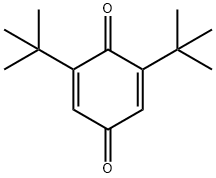2,6-Di-tert-butyl-p-benzoquinone
- CAS NO.:719-22-2
- Empirical Formula: C14H20O2
- Molecular Weight: 220.31
- MDL number: MFCD00001601
- EINECS: 211-946-0
- SAFETY DATA SHEET (SDS)
- Update Date: 2025-01-27 09:38:02

What is 2,6-Di-tert-butyl-p-benzoquinone?
Chemical properties
ORANGE TO BROWN CRYSTALS OR CRYSTALLINE POWDER
The Uses of 2,6-Di-tert-butyl-p-benzoquinone
2.6-Di-tert-butyl-p-benzoquinone was used as a treatment agent to improve germination, plant health and yield.
The Uses of 2,6-Di-tert-butyl-p-benzoquinone
2,6-Di-tert-butyl-1,4-benzoquinone was used as an antioxidant to study the elimination rate of micro pollutant from storm and waste water. It was also used as a metabolite of butylated hydroxytoluene. It is used as a treatment agent to improve germination and plant health.
What are the applications of Application
2,6-Di-tert-butyl-1,4-benzoquinone is a treatment agent to improve germination
Definition
ChEBI: 2,6-Di-tert-butylbenzoquinone is a member of 1,4-benzoquinones.
Synthesis Reference(s)
The Journal of Organic Chemistry, 30, p. 982, 1965 DOI: 10.1021/jo01015a006
Tetrahedron Letters, 30, p. 5929, 1989 DOI: 10.1016/S0040-4039(01)93508-7
Purification Methods
It can be recrystallised from MeOH and sublimes in a vacuum. [Beilstein 7 IV 2116.]
Properties of 2,6-Di-tert-butyl-p-benzoquinone
| Melting point: | 65-67 °C(lit.) |
| Boiling point: | 75-80 °C (0.7 mmHg) |
| Density | 1.0106 (rough estimate) |
| refractive index | 1.4970 (estimate) |
| Flash point: | >110°(230°F) |
| storage temp. | Amber Vial, -20°C Freezer, Under inert atmosphere |
| solubility | Chloroform (Slightly), Methanol (Slightly) |
| form | Crystals or Crystalline Powder |
| color | Orange to brown |
| Water Solubility | Insoluble in water. |
| BRN | 1911512 |
| Stability: | Light sensitive |
| CAS DataBase Reference | 719-22-2(CAS DataBase Reference) |
| NIST Chemistry Reference | 2,5-Cyclohexadiene-1,4-dione, 2,6-bis(1,1-dimethylethyl)-(719-22-2) |
| EPA Substance Registry System | 2,6-Di-tert-butylbenzoquinone (719-22-2) |
Safety information for 2,6-Di-tert-butyl-p-benzoquinone
| Signal word | Warning |
| Pictogram(s) |
 Exclamation Mark Irritant GHS07 |
| GHS Hazard Statements |
H315:Skin corrosion/irritation H319:Serious eye damage/eye irritation H335:Specific target organ toxicity, single exposure;Respiratory tract irritation |
| Precautionary Statement Codes |
P302+P352:IF ON SKIN: wash with plenty of soap and water. P305+P351+P338:IF IN EYES: Rinse cautiously with water for several minutes. Remove contact lenses, if present and easy to do. Continuerinsing. |
Computed Descriptors for 2,6-Di-tert-butyl-p-benzoquinone
2,6-Di-tert-butyl-p-benzoquinone manufacturer
SPARKVEE FINE CHEMICALS PRIVATE LIMITED
New Products
4,4-Difluoropiperidine hydrochloride tert-butyl 9-methoxy-3-azaspiro[5.5]undecane-3-carboxylate Indole Methyl Resin N-Isopropylurea N,N-Dicyclohexylcarbodiimide(DCC) MELDRUMS ACID 5-METHYLISOXAZOLE-4-CARBOXYLIC ACID Magnessium Bis glycinate Zinc ascorbate 1-bromo-2-butyne 2-acetamidophenol 9(10H)-anthracenone Erythrosin B, 4-Piperidinopiperidine 2-((4-morpholinophenylamino) (methylthio) methylene) malononitrile 2,4-dihydroxybenzaldehyde 3-(4-morpholinophenylamino)-5-amino-1H-pyrazole-4-carbonitrile Methyl 2-methylquinoline-6-carboxylate 2,6-dichloro-4-nitropyridine 4-Bromo-2-chlorobenzonitrile 2-(benzylamino)acetic acid hydrochloride 4-(tert-Butoxycarbonylamino)but- 2-ynoic acid 3,4-dihydro-2H-benzo[b][1,4]dioxepine 1-Phenyl-1-cycloprppanecarboxylicacidRelated products of tetrahydrofuran






![Benzo[b]thien-2-ylboronic acid](https://img.chemicalbook.in/CAS/GIF/98437-23-1.gif)

You may like
-
 719-22-2 2,6- Di-Tert-Butyl-p-Benzoquinone NLT 98%View Details
719-22-2 2,6- Di-Tert-Butyl-p-Benzoquinone NLT 98%View Details
719-22-2 -
 2,6-Di-tert-butyl-1,4-benzoquinone CAS 719-22-2View Details
2,6-Di-tert-butyl-1,4-benzoquinone CAS 719-22-2View Details
719-22-2 -
 2,6-Di-tert-butyl-1,4-benzoquinone CAS 719-22-2View Details
2,6-Di-tert-butyl-1,4-benzoquinone CAS 719-22-2View Details
719-22-2 -
 3-(4-amino-1-oxoisoindolin-2-yl)-1-methylpiperidine-2,6-dione 98%View Details
3-(4-amino-1-oxoisoindolin-2-yl)-1-methylpiperidine-2,6-dione 98%View Details -
 20677-73-0 (2,2-diethoxyethyl)methylamine 98%View Details
20677-73-0 (2,2-diethoxyethyl)methylamine 98%View Details
20677-73-0 -
 3-(4-(hydroxyamino)-1-oxoisoindolin-2-yl)piperidine-2,6-dione 98%View Details
3-(4-(hydroxyamino)-1-oxoisoindolin-2-yl)piperidine-2,6-dione 98%View Details -
 57381-49-4 2-bromo-4-chlorobenzonitrile 98%View Details
57381-49-4 2-bromo-4-chlorobenzonitrile 98%View Details
57381-49-4 -
 4,6-dichloropyrimidine-5-carbaldehyde 98%View Details
4,6-dichloropyrimidine-5-carbaldehyde 98%View Details
5305-40-8
